Corporate museums are part academic and business and occupy the grey zone in between. It is an organization that works with several departments in a company including public relations, branding, advertising, and HR. This series aims to look at the role, function, and future of museums run by corporations through interviews with PR professionals.
Vacuum Bottle & Air Pot Pavilion—pride in professionalism and a heart for hospitality
They keep water chilled on hot summer days and tea warm on cold winter days. Whether it was sports day or a field trip, I’ve been using a vacuum bottle since I was a kid, and I’m sure they’ve helped many others take a moment to relax with a cool drink or a warm one, outside or at home. Until now, I’d never put much thought into how they work, but now that I’ve given it some thought, I know why they are called “magic bottles” in Japanese. However, there’s no magic in manufacturing. In this article, I’d like to show you what makes Vacuum Bottle & Air Pot Pavilion such a great place while unraveling the history of vacuum bottles and how they work.
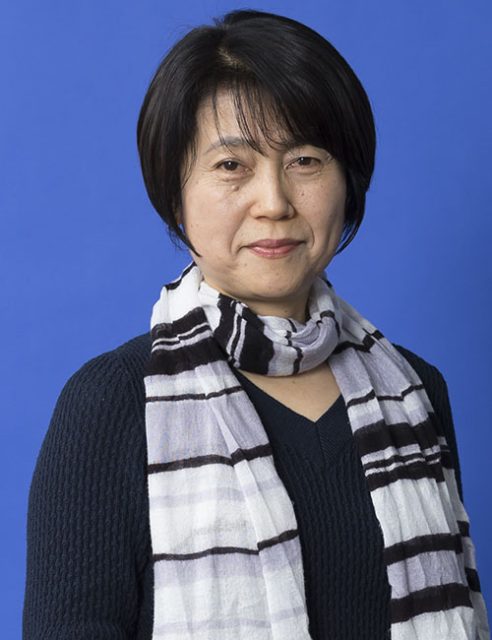
Ikuyo Nakagawa, PR Consulting Dentsu Inc.
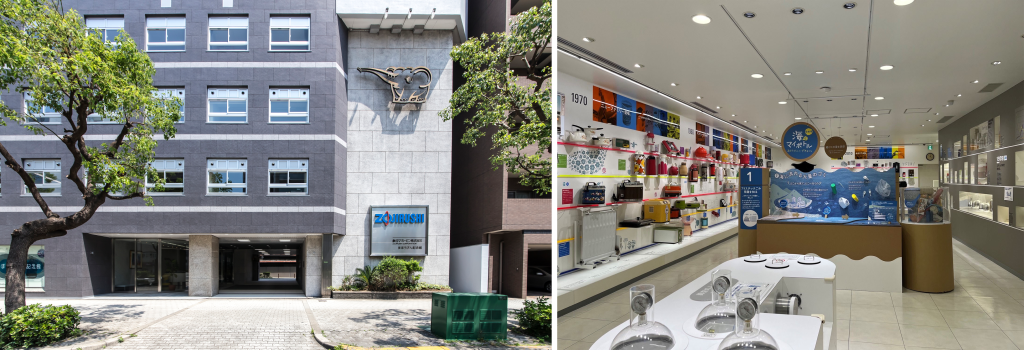
Vacuum Bottle & Air Pot Pavilion, located on the first floor of the head office of Zojirushi Corporation (Tenma, Kita Ward, Osaka City). The photo on the right was taken by the writer.
A place to learn about the technology behind vacuum bottles and what makes them so great
In the heat of late August, I visited Vacuum Bottle & Air Pot Pavilion in Tenma, Kita Ward, Osaka. The museum is located on the first floor of Zojirushi Corporation Headquarters and operated by the company. Before entering the museum, I kept myself refreshed with the vacuum bottle, of course made by Zojirushi, I brought along. I still think it’s amazing that I can have cold, fresh water even on such a hot day.
The museum was opened in 2008 to commemorate the 90th anniversary of the founding of Zojirushi Corporation. In addition to introducing the history of the development and evolution of the Japanese vacuum bottle industry from its early days to the general public, it also exhibits a collection of about 350 items from Japan and overseas all focused on vacuum bottles. Zojirushi renewed the museum in 2018, the 100th anniversary of the company’s founding, and they also newly opened Forest of Flasks, an exhibition area with 110 vacuum bottles in different colors, shapes, and materials.
A wide variety of vacuum bottles, from Arita ware to some with character designs, are on display in this forest, and the lights in vacuum bottles made of glass create a sense of unity and a comfortable atmosphere. There are also rare items that can only be seen here, such as 100-year-old vacuum bottles, that are sure to fascinate you with a perspective on the world of vacuum bottles that you’ve never seen before.
In addition, the museum shows their support for space development and new technologies that contribute to various industries including sports. They make it easy for visitors to appreciate the high technological capabilities of Japanese vacuum bottles. Vacuum Bottle & Air Pot Pavilion represents the industry and serves as a base for communicating the technology and charm of vacuum bottles from Osaka to the whole country, and even the world.
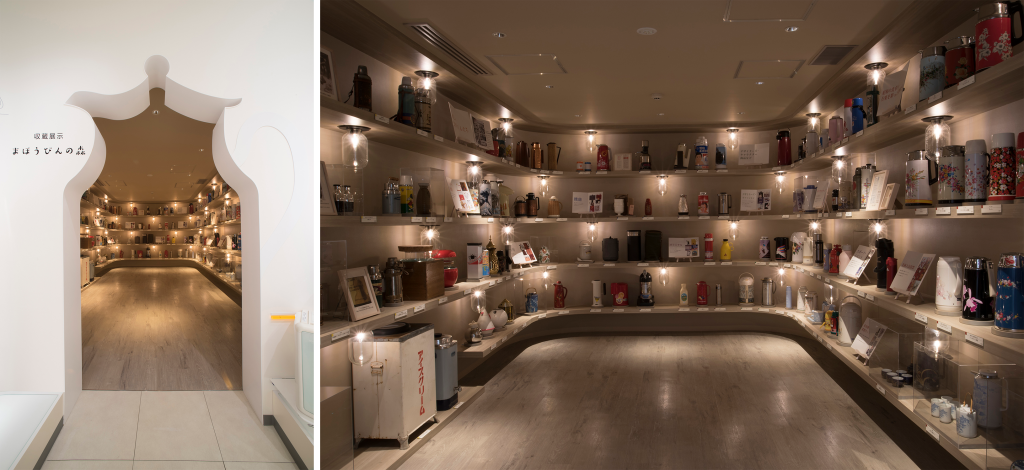
Forest of Flasks, newly established after the renovation
The reason why "mahobin" is written in hiragana
There’s a reason why “Mahobin” in the museum’s name is written in hiragana (phonetic lettering) rather than kanji (logographic Chinese characters). This is so people of all ages, from small children to adults, who visit the museum can enjoy the various products that have evolved with the times from their own perspectives. At the entrance, a video picture book that introduces the origin of the vacuum bottle welcomes you in a friendly way. The animation showcases the progress of humans’ efforts to keep things warm and cold, from ancient times to the beginning of vacuum bottles, in an interesting way that holds the attention of adults and is easy for children to understand.
In addition, the museum has an experimental device where you can experience the wonder of a vacuum that shows how vacuum bottles work, and people can enjoy these facilities with all their senses. Vacuum bottles were a necessity for sports day or field trips, but many people now, like myself, carry them to protect themselves from heatstroke or for sustainability purposes, regardless of how old they are or where they are going. It reminds us that vacuum bottles, which are great at keeping drinks cool or warm, have long been an indispensable part of our daily lives.
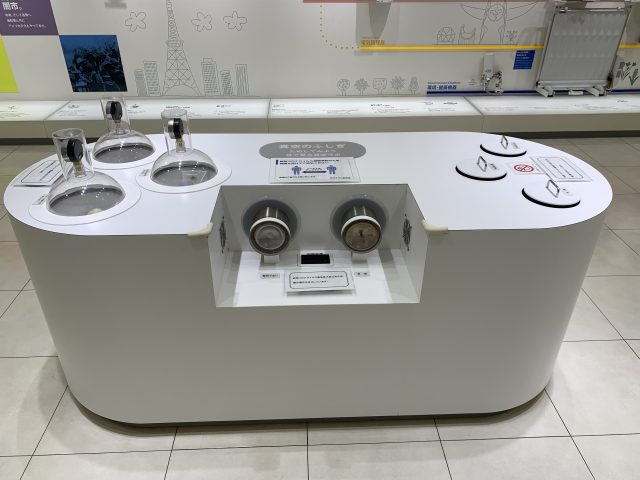
Experimental equipment to experience a vacuum (currently suspended due to COVID-19).
Employee guided tours even for individual visitors
There’s another reason why this memorial museum was opened on the first floor of the head office. Being on the first floor gives you easy access to the museum and has more opportunities for developing employees’ awareness and communicating with business partners. More importantly, admission to the museum has always been by reservation only so that employees in charge of public relations can guide you. For this reason, the museum is closed on Saturdays, Sundays, and national holidays when the company is closed. Guides are conducted three times a day on weekdays, each approximately one hour long. Even if you make a reservation just for yourself, you’ll have a guide.
I wondered if other facilities also have comprehensive service like this. When I asked Naoya Takayanagi of Taisho University, who specializes in research on corporate museums, he said, “It’s very rare to have a guided tour by an employee, especially if it’s reserved for one person. It’s often conducted for business partner companies, but there are few cases of a policy to always do tours for general visitors, even among the many corporate museums.” It’s the ultimate kind of hospitality that ignores efficiency.
Rather than focusing on the total number of visitors, the museum has a policy of taking care of every single visitor, and it has been thoroughly carried out. However, due to COVID-19 and taking into consideration the risk of infection during 40 or 50 minutes of discussions with visitors, they also offer free audio guides on tablets with the same content available to those who wish to use them. Audio guides are available in English and Chinese for visitors from overseas. Since each guided tour is generally for only one group, even those who traveled from abroad had unfortunately been refused reservations due to schedule conflicts. However, the use of tablets can solve these problems, resulting in an increasing the number of visitors.
The history of vacuum bottles goes back 100 years
More than 100 years have passed since the birth of heating and cooling technology through vacuum power. There’s a replica of the flask that became the prototype of the vacuum bottle on display in the museum. The Dewar flask, invented by British chemist James Dewar in 1892, is a symbol of the museum. It’s a glass vacuum insulation container that makes a vacuum inside of the double walls of the inner and outer bottles, taking advantage of the fact that heat cannot be transmitted in a vacuum.
Vacuum bottles made in Europe were imported to Japan at the end of the Meiji period, and the Japanese vacuum bottle industry developed mainly in Osaka, where the glass industry flourished at that time. This is why many vacuum bottle manufacturers still have their headquarters in Osaka. One of them is Zojirushi Corporation. The founders were Ginzaburo Ichikawa and his younger brother Kinzaburo. Kinzaburo was a craftsman of lightbulbs who became interested in vacuum bottles. The siblings established Ichikawa Brothers Trading Company in 1918 to manufacture the glass lining of vacuum bottles.
Originally, incandescent lightbulbs had similar origins to the vacuum industry, and it seems that there was a technical connection with manufacturing the inner lining of vacuum bottles with glass. Before long, they started to make their own vacuum bottles from the inner linings they were manufacturing, which led to the current Zojirushi vacuum bottles. Since then, the company has continued to evolve based on vacuum insulation technology, and to this day, has been creating products from the perspective of always providing convenience and comfort to people’s daily lives. The history of vacuum bottles is the history of Zojirushi. It has also changed the lifestyle of Japanese people over the past 100 years.
On the right side of the main hall of the museum, the history and technology of vacuum bottles are showcased, while on the left side, the history of the company is on display. Among the many vacuum bottles that have colored the times, there are some familiar ones that I used at home when I was a child. Looking back and seeing the products of the past is another way to enjoy the museum.
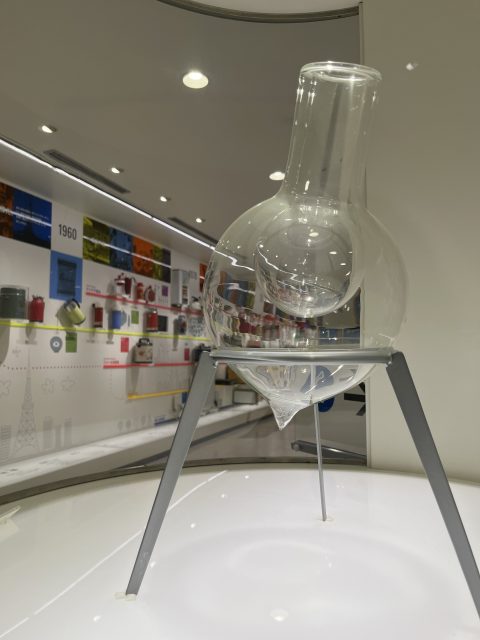
A replica of the “Dewar flask,” the prototype of the vacuum bottle. (Photo by the writer)
A closer look reveals Zojirushi is in your life
I’d also like to give a brief introduction of the Zojirushi brand. The elephant was chosen for the logo for its popularity with children, long lifespan, and strong familial bonds. In 1928, five years after its establishment, the company released the first vacuum bottle with an engraved Zojirushi mark. Incidentally, since there was demand overseas where raw water was not suitable for drinking (without boiling it) and elephants were popular and regarded as sacred animals in Southeast Asia—the company’s main export destination—the trademark of ELEPHANT&CROWN, along with an illustration of an elephant wearing a crown, were used for exports. Although the current logo has shifted to a simple one compared to those days, the familiar elephant symbol is still used today.
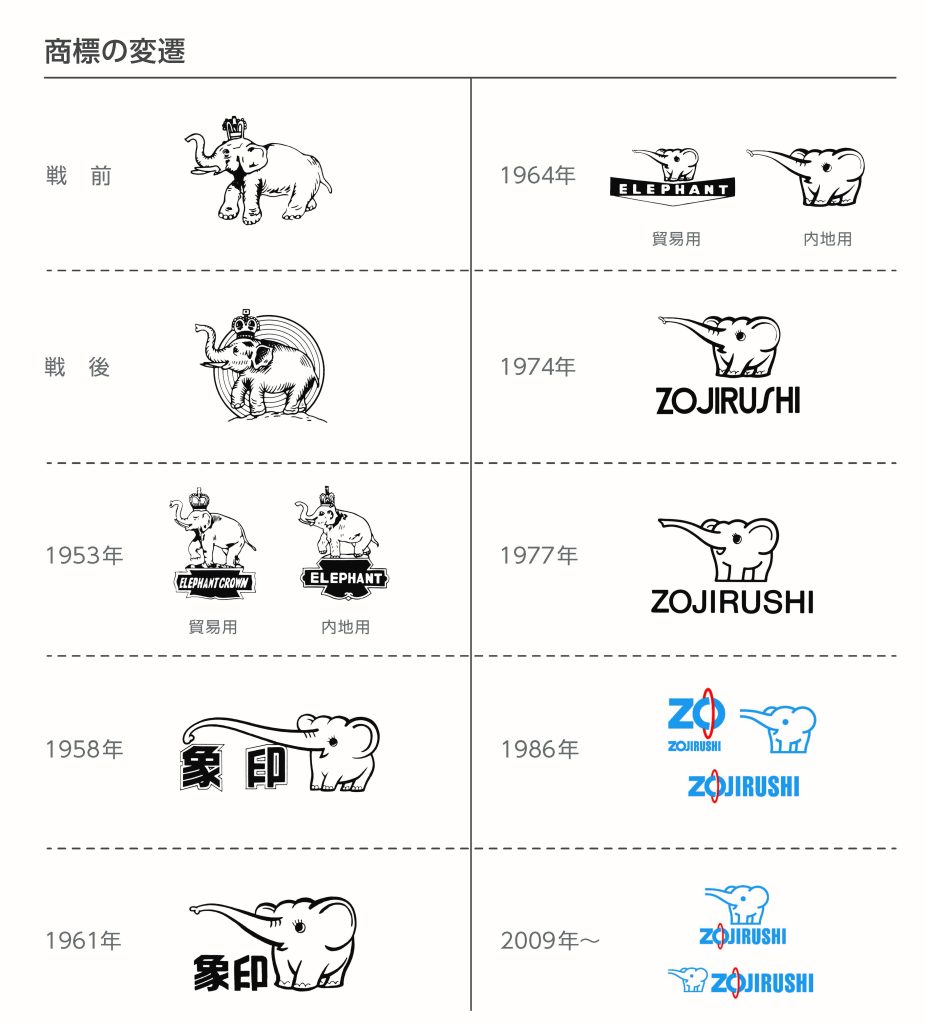
The evolution of the Zojirushi logo.
There’s no goal in manufacturing and the vacuum bottle evolved from glass to non-breakable stainless-steel. When people started carrying them around everyday, the company made them smaller and lighter. Zojirushi’s customer-first approach led them to develop other products despite being a vacuum bottle manufacturer. In time, their desire to create products that people needed led them to manufacture electric rice cookers.
In 1970, the world’s first electric rice cooker was released and was a huge success. Many of you may remember it. In the midst of Japan’s high economic growth period, the cookers must have also warmed the hearts of people, like children waiting for their parents to get home or fathers getting home late.
Someone else’s trouble is the starting point of all manufacturing, like with the creation of a monitoring pot equipped with a safety confirmation system to check up on family members that live far away. The corporate philosophy, “Creating a Better Quality of Life,” hasn’t changed since the company’s founding. There are countless Zojirushi brands that have been released worldwide. When I looked through my house, I found that the mug and two humidifiers I have are from Zojirushi. It’s a part of my life and I hadn’t even noticed.
An attitude of taking on challenges for the future
As I mentioned above, Zojirushi’s new technologies are being utilized in a variety of fields, such as space development and sports. In 2004, they also went into space. Zojirushi was asked by the Japan Aerospace Exploration Agency (JAXA) to produce a stainless-steel vacuum insulation container for experiments at the International Space Station. The product they developed achieved the strength to withstand the powerful 40 G impact at the time of rocket launches, and demonstrated its high technological capabilities to the world. The impact of a fighter jet landing on an aircraft carrier is said to be 7 G, so the impact of 40 G is extraordinary.
In addition, Mizuki Noguchi, a female marathon runner who won a gold medal at the Athens Olympics, used a water bottle made by Zojirushi. The bottle was designed for athletes to keep them cool with its supply of water. Noguchi said, “This bottle saved me.” As proven by the various products that evolve with the times, Zojirushi’s attitude of taking on challenges for the future hasn’t changed since day one 100 years ago.
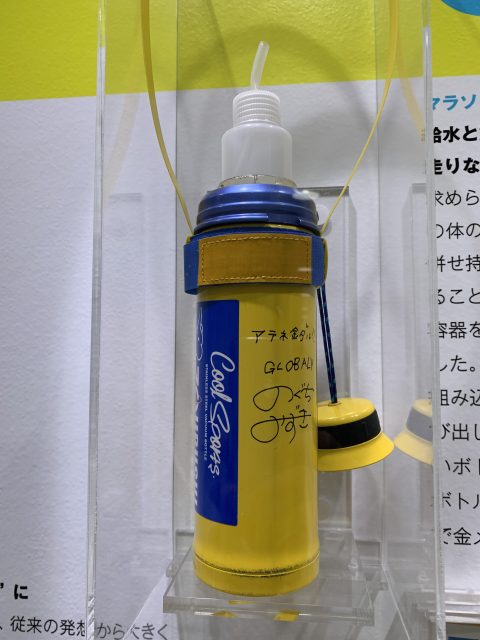
The water bottle that Noguchi actually used. A spring structure is incorporated into the water bottle that pushes the bottle up when the cap is opened, making it easy to drink even while running at full speed.
Deeper understanding through attractive feature exhibitions
About 17,000 people have visited the museum, even though tours are only offered on weekdays with limited availability. Kazumi Sugiyama, Director of the museum, said that feature exhibitions, available for a limited time, are also as popular as the permanent exhibitions. “‘The Sea and My Vacuum Bottle,’ which is currently being held, was scheduled to run from November last year until April, but it has been extended to December 27 due to popular demand,” she said.
“The vacuum bottle that you use are products that keep you warm and cool without any energyl. Unlike disposable PET bottles, it’s also an environmentally friendly product that reduces plastic waste through repeated use and contributes to reducing CO2 emissions. I hope it’ll be an opportunity to think about what we can do now. We’d like to continue promoting our products through various feature exhibitions so that you can learn more about the vacuum bottles that you’re so familiar with.”
The feature exhibition seems to play a role as a medium. The message conveyed through the feature exhibitions is an opportunity for visitors to think about environmental issues, which I think can be done on a deeper level, and maybe even bringing them back for another visit to the museum. (Currently, in order to prevent the spread of the COVID-19, explanations of the exhibitions are limited to only to those who request them.)
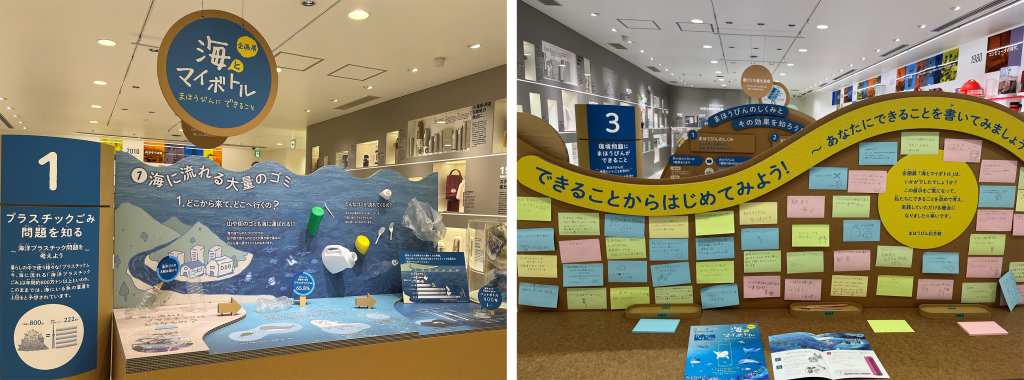
Feature exhibition of “The Sea and My Vacuum Bottle.” (Photo by the writer)
The reason "Mahobin" is still used in the company name
Lastly, I asked why the company has continued to use “Mahobin,” “magic bottle” in Japanese, in the company name. The company has already released a wide variety of products to the world, and other companies often change their names to coincide with their 100th anniversary. What could their reason be for not changing? They responded with, “To be precise, we changed our name twice from ‘Ichikawa Keitei Shokai’ (Ichikawa Brothers Trading Company) but since the company started by manufacturing the interior vacuum bottle, we have continued to our main product ‘Mahobin‘ in the company name”
Their answer made it clear what the company values the most. They started as a vacuum bottle company to keep warm things warm and cold things cold. It shows Zojirushi’s enthusiasm for managing heat for customers, and their attitude for enriching people’s lives. Everything is for their customers. Zojirushi’s stance of valuing individual visitors extends past their museum visitors. This attitude is built by their employees who have taken pride in the Zojirushi brand over the past 100 years. Moreover, they have the pride of professionals who do their absolute best in each position to keep their customers happy. You can clearly see their enthusiasm in the guides as they take you through the museum.
Instead of pursuing many visitors, they use a system where one of the visitors could become a brand ambassador through what they learned, and if they share the story of Zojirushi with others, the number of fans of the company will keep going up. I could feel the strength of Zojirushi.
Note: The information contained in this article is as of August 2022.
